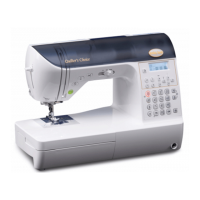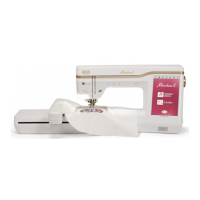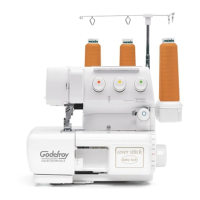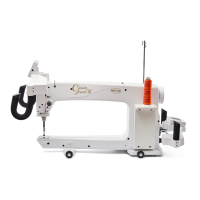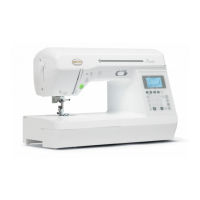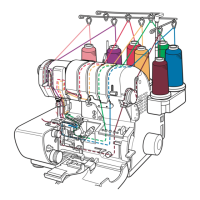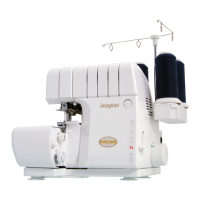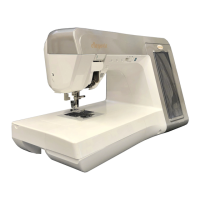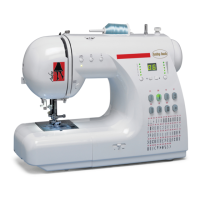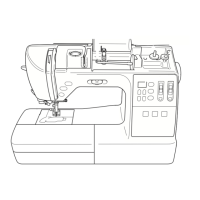
Do you have a question about the Baby Lock Melody BLMY and is the answer not in the manual?
| Maximum Stitch Width | 7 mm |
|---|---|
| Maximum Stitch Length | 5 mm |
| Needle Threading System | Automatic |
| Drop-in Bobbin | Yes |
| LCD Display | Yes |
| Weight | 13.5 lbs |
| Bobbin Type | Class 15 |
| Maximum Sewing Speed | 850 stitches per minute |
| Feed System | Drop Feed |
| Lighting | LED |
| Start/Stop Button | Yes |
| Speed Control | Yes |
| Needle Up/Down | Yes |
| Type | Electronic Sewing Machine |
Safety instructions for operating the sewing machine, covering basic precautions.
Guidelines for maintaining the machine's longevity, including storage and cleaning.
Reduces the risk of electric shock by outlining essential precautions for safe operation.
Addresses risks of burns, fire, electric shock, and injury, providing preventative measures.
Details special care needed during sewing operations to prevent accidents or damage.
Emphasizes that the machine is not a toy and requires adult supervision, especially around children.
Covers the basic steps and procedures for operating the sewing machine.
Explains how to adjust thread tension for optimal stitch quality and consistency.
Details how to modify stitch width and length settings for various sewing needs.
Describes helpful functions that enhance sewing efficiency and convenience.
Offers practical advice and tips for achieving better results in sewing projects.
Highlights the key features and capabilities of the sewing machine.
Details the specific accessories that should be included in the product packaging.
Lists accessories that are available for purchase separately to enhance machine functionality.
Details the parts of the sewing machine visible from the front.
Identifies and explains parts related to the needle and presser foot mechanism.
Details the parts of the sewing machine visible from the right and rear sides.
Provides instructions on how to properly turn the sewing machine on and off.
Explains the information displayed on the sewing machine's LCD screen.
Guides the user on how to adjust various machine settings for personalized use.
Details the process of winding thread onto a bobbin and inserting it into the machine.
Explains the steps for threading the upper thread through the sewing machine.
Provides instructions on how to safely and correctly replace the sewing machine needle.
Guides the user on how to change the presser foot for different sewing tasks.
Offers guidance on sewing challenging fabric pieces like cylindrical items or large fabric sheets.
Outlines critical safety precautions related to the power supply and electrical connections.
Describes the general procedure for modifying machine settings and attributes.
Details how to adjust the brightness level of the LCD screen for better visibility.
Explains how to change the display language of the sewing machine's interface.
Highlights essential precautions to observe when handling and using bobbins.
Provides step-by-step instructions for winding thread onto the bobbin.
Guides the user on how to correctly insert the wound bobbin into the bobbin case.
Explains the procedure for threading the upper thread through the sewing machine.
Details how to thread the needle manually when the automatic threader cannot be used.
Explains how to thread and use the twin needle for parallel stitching.
Provides crucial precautions for safely handling and replacing the sewing needle.
Lists different needle types and their appropriate applications based on fabric and thread.
Explains how to check the needle for straightness before use to prevent damage or injury.
Guides the user on how to safely and correctly replace the sewing machine needle.
Highlights essential precautions to observe when changing the presser foot.
Provides instructions on how to safely and correctly attach and remove presser feet.
Explains how to adjust the presser foot pressure for different fabric types and sewing results.
Details the procedure for removing the presser foot holder for cleaning or accessory attachment.
Guides the user on how to attach and use the walking foot for even fabric feeding.
Explains how to sew cylindrical fabric parts like cuffs and pant legs using the free arm.
Provides instructions on using the extension table to facilitate sewing large fabric pieces.
Covers the basic steps and procedures for operating the sewing machine.
Explains how to correctly position the fabric under the presser foot before sewing.
Details how to start and stop the sewing process using controls or the foot controller.
Explains how to use reverse or reinforcement stitches to secure the end of seams.
Describes methods for cutting the thread after completing sewing operations.
Explains how to adjust thread tension for optimal stitch quality and consistency.
Details the process of adjusting the upper thread tension using the machine's controls.
Explains how to modify the stitch width setting for various sewing needs.
Details how to adjust the stitch length setting for desired stitch appearance.
Guides on setting the needle to stop up or down in the fabric after sewing.
Explains how to set the machine for automatic reverse or reinforcement stitches at seam ends.
Details how to enable the automatic thread cutting feature at the end of stitching.
Describes how to save custom stitch settings for future use.
Explains how to use the knee lifter for hands-free control of the presser foot.
Recommends sewing a test piece to check settings before working on the actual project.
Guides on how to change the sewing direction, especially when turning corners.
Provides advice on sewing smooth curves, including stitch length adjustments.
Offers tips for sewing through thick fabrics, including presser foot adjustments.
Provides guidance on sewing thin fabrics, suggesting stabilizer use to prevent misalignment.
Offers tips for sewing stretch fabrics, recommending basting and appropriate stitches.
Advises on using a non-stick foot for sewing materials like leather or vinyl to prevent sticking.
Explains methods for maintaining a consistent seam allowance while sewing.
Guides on selecting the appropriate stitch type and pattern for various sewing tasks.
Explains how to use overcasting stitches to finish fabric edges and prevent fraying.
Covers essential straight stitches used for plain seams and general sewing.
Details the process of creating blind hems for neat and invisible finishes.
Explains how to sew buttonholes and attach buttons using the machine.
Guides on inserting zippers into garments and other fabric items.
Covers techniques for inserting zippers and piping for decorative or functional purposes.
Provides methods for sewing stretch fabrics and attaching elastic tape effectively.
Covers stitches and techniques for appliqué, patchwork, and quilting projects.
Explains how to use reinforcement stitches to strengthen stress points in garments.
Details how to create eyelets for decorative or functional purposes on fabric.
Describes horizontal stitching techniques for attaching appliqués to immovable fabric.
Introduces various decorative stitches for embellishing fabrics and projects.
Guides on using built-in decorative patterns, including combining and adjusting them.
Provides an overview of available stitch types and patterns for selection.
Guides on how to select the desired stitch using direct or number selection methods.
Details how to use the overcasting foot 'G' for sewing overcasting stitches.
Explains how to use the zigzag foot 'J' for sewing overcasting stitches.
Guides on using the optional side cutter for overcasting stitches and fabric edge cutting.
Explains how to perform basting stitches for temporary fabric assembly.
Covers essential straight stitches used for plain seams and general sewing.
Explains the process of sewing buttonholes using the machine's specialized foot and settings.
Guides on how to attach buttons securely using the sewing machine.
Details the steps for inserting a centered zipper into fabric.
Explains the process of inserting a side zipper into fabric pieces.
Details the steps for inserting a centered zipper into fabric.
Guides on how to insert piping for decorative edging or seams.
Provides methods for sewing stretch fabrics effectively without distortion.
Details how to attach elastic tape to garments for waistbands or cuffs.
Explains stitching techniques for creating patchwork and crazy quilt designs.
Describes how to achieve a hand-quilted look using the sewing machine.
Covers the technique of piecing fabric pieces together, typically for quilting or patchwork.
Guides on sewing appliqué designs onto fabric for decorative purposes.
Explains the technique of piecing fabric pieces together, typically for quilting or patchwork.
Details how to use the 1/4 inch quilting foot for precise seam allowances.
Covers the process of sandwiching batting between fabric layers for quilting.
Explains how to use the quilting guide for sewing evenly spaced parallel stitches.
Guides on free-motion quilting, involving lowering feed dogs for fabric control.
Explains how to adjust stitch width for satin stitching using the sewing speed controller.
Explains the use of triple stretch stitching for reinforcing seams in stretchy fabrics.
Details how to sew bar tacks to reinforce stress points like pocket corners.
Guides on using the darning stitch to repair torn or worn fabric areas.
Explains how to sew fagoting stitches across open seams for decorative bridging.
Covers joining stitches used for decorative bridging over seam allowances.
Details the shell tuck stitch for decorative trims on blouses and cuffs.
Explains the smocking stitch for adding texture and elasticity to fabrics.
Describes the scallop stitch for decorating edges like collars and handkerchiefs.
Covers hemstitching techniques for decorative hemming and heirloom finishes.
Details settings for the ladder stitch, a decorative hemming technique.
Lists settings for the rick-rack stitch, a decorative zigzag pattern.
Covers general decorative stitches for embellishment.
Explains settings for the serpentine stitch, used decoratively and for elastic attachment.
Covers joining stitches used for decorative bridging over seam allowances.
Explains heirloom stitching techniques, often used with wing needles for decorative effect.
Provides considerations for sewing patterns correctly, including fabric and needle choices.
Guides on selecting and preparing patterns for sewing on the machine.
Explains how to combine multiple decorative or character stitches for custom designs.
Details how to set the machine to repeatedly sew a combined pattern.
Guides on how to check combined patterns that may not fit entirely on the LCD.
Explains how to switch between large and small sizes for certain decorative and character patterns.
Details how to adjust the stitch density for decorative satin stitches.
Explains how to adjust the length of satin stitch components.
Guides on accessing and loading previously saved stitch patterns.
Details how to adjust patterns for correct alignment based on fabric and sewing speed.
Lists detailed settings for various stitches, including width, length, and presser foot.
Provides specific settings and applications for utility stitches.
Lists settings and applications for decorative, character, and other special stitches.
Details procedures for cleaning and maintaining the sewing machine.
Explains how to clean the exterior surfaces of the sewing machine.
Guides on cleaning the bobbin race area to ensure optimal sewing performance.
Offers solutions for common problems encountered during machine operation.
Lists and explains error messages displayed on the LCD screen.
Provides solutions if the LCD screen remains blank during operation.
Explains the function of beeps and how to disable them for certain operations.
Guides on disabling the operation beep feature for quieter use.
An alphabetical index to help locate specific topics within the manual.
Details settings for straight stitches, including needle position and application.
Lists settings for the triple stretch stitch, used for reinforcing seams.
Provides settings for the stretch stitch, suitable for elastic fabrics.
Details settings for the basting stitch, used for temporary fabric assembly.
Lists settings for zigzag stitches, including applications like overcasting.
Details settings for the 2-point zigzag stitch, used for overcasting and attaching elastic.
Provides settings for the 3-point zigzag stitch, useful for stretch fabrics and overcasting.
Lists settings for overcasting stitches, used to finish fabric edges.
Details settings for blind hem stitches, used for neat and invisible hems.
Provides settings for the appliqué stitch, used for attaching decorative fabric pieces.
Details settings for the shell tuck stitch, used for decorative trims.
Lists settings for piecing straight stitches, used in quilting and patchwork.
Details settings for stitches that mimic hand-sewing for quilting.
Provides settings for zigzag stitches used in quilting and appliqué.
Lists settings for appliqué stitches used in quilting projects.
Details settings for quilting stippling stitches.
Provides settings for the satin scallop stitch, a decorative edge finish.
Lists settings for joining stitches used in patchwork.
Details settings for the smocking stitch, used for decorative gathering.
Explains settings for fagoting stitches used across open seams.
Provides settings for attaching elastic to fabrics.
Details settings for the ladder stitch, a decorative hemming technique.
Lists settings for the rick-rack stitch, a decorative zigzag pattern.
Covers general decorative stitches for embellishment.
Explains settings for the serpentine stitch, used decoratively and for elastic attachment.
Details settings for the button sewing stitch used to attach buttons.
Provides settings for creating eyelets on fabric.
Lists settings for horizontal straight stitches used for appliqués.
Details settings for horizontal zigzag stitches used for appliqués.
Lists settings and applications for various decorative stitches.
Provides settings for satin stitches, used for decorative effects.
Details settings for step patterns created by shifting satin stitches.
Lists settings for cross stitches, used for decorative patterns.
Provides settings for decorative satin stitches, combining satin and decorative elements.
Explains how to clean the exterior surfaces of the sewing machine.
Guides on cleaning the bobbin race area to ensure optimal sewing performance.
Addresses issues where the sewing machine fails to start or function.
Provides remedies for problems causing the needle to break during sewing.
Offers solutions for common causes of upper thread breakage.
Provides guidance for resolving issues with the lower thread tangling or breaking.
Addresses problems related to incorrect upper and lower thread tension settings.
Offers solutions for fabric wrinkling issues during sewing.
Provides remedies for skipped stitches, often related to needle or threading issues.
Addresses causes and solutions for unusual noises during machine operation.
Offers solutions for issues preventing the use of the automatic needle threader.
Provides remedies when stitches are improperly formed or appear incorrect.
Addresses problems related to the fabric feed mechanism not functioning correctly.
Offers solutions if the sewing machine's lamp fails to illuminate.
Provides solutions if the LCD screen remains blank during operation.
Guides on disabling the operation beep feature for quieter use.
